All the beautiful horses
Host: Abingdon Downs Station
Written by Renee Kohler – Station Hand, Abingdon Downs Station.
Renee Kohler and her husband, Jason, have been with us or 11 ½ years. Renee has a special skill in remembering every single horse that has been through our yards since she has been here. She remembers who rode what and when. She remembers every illness each horse may have had. It would be fair to say that Renee is horse mad.
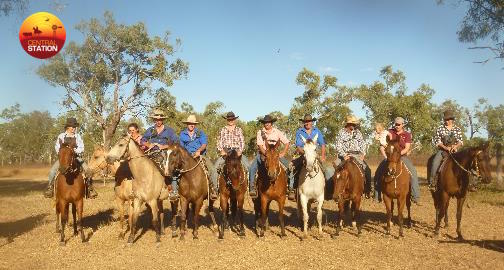 Some of station horse plant.
Some of station horse plant.
What draws a person to work on a station? For me it was the horses. I couldn’t think of anything better than to be able to ride and work with horses for the most part of my job. Sure there’s a lot of fencing and maintenance jobs to do throughout the season, but I actually enjoy that too!
We are lucky enough to be employed by two really wonderful horsemen who have taught us so much, from the basics to breaking in youngsters to cutting out cattle and so much in between. At Abingdon we use only Quarter Horses. We love them for their temperaments, their build, and their natural ability to work a cow. We breed all of our own horses and have been lucky enough to have a couple of really good stallions that we purchased for breeding. Currently we have a “TR Dual Rey” stallion (TR Dual Rey is a very successful cutting stallion in the US) and a “Pepto Stylish Oak” stallion (a hugely successful cutting stallion imported from the US to Australia) and they have produced some pretty special foals. The mares we use for breeding are mainly station mares but we brought in some very well bred cutting trained mares.
Then there’s the other “special” horses. These ones rarely mix with the working horses and are stabled and fed every day. At the end of every season all the working horses get put out to pasture away from the homestead, but not these ones, they really do have special rights! When the mangoes are falling from the trees these ‘special’ horses are allowed in the house complex to “clean up” some of the mangoes. These horses are the bosses horses, including “Duster” the 28 year old in retirement.
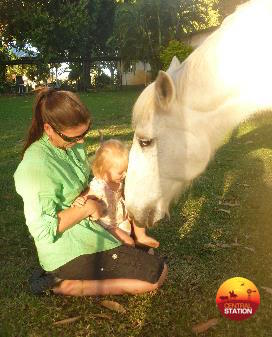 Duster, one of the ‘special’ ones.
Duster, one of the ‘special’ ones.
All the station horses are mustered back to the homestead at the start of the season to be assigned their jockey for the year. Each person generally gets three horses for the year which they will look after as their own for the season. They will rotate their horses each mustering day. Some of the more experienced riders will be given a young horse to either break in or put some miles under saddle. All these horses then become the “working plant”.
There are about 70 horses to get drafted, wormed, checked for injuries and problems, such as swamp cancer. Swamp cancer is not a cancer, rather an aquatic fungal infection. Over the wet when it is hot the horses tend to spend a fair part of their day standing in lagoons to keep cool. If they have a cut or a sore the fungus can get into their system and form a big lesion that, in worse case scenario’s, can be fatal. Vets are called out if any are showing signs of swamp cancers. What horses are not being used for the year are returned to their paddock to await next year’s crew.
Then the work starts on the plant horses. Usually a couple of weeks are spent putting shoes on their horses and riding them to get them fit again. Those who have ones to break in make a start on that by doing a lot of ground work in the round yards then saddling and getting on for the first time. It can get quite exciting this time of year, not just for the first rides on the young horses but for the older horses too who can get a bit “fresh” (excited) after their big break!
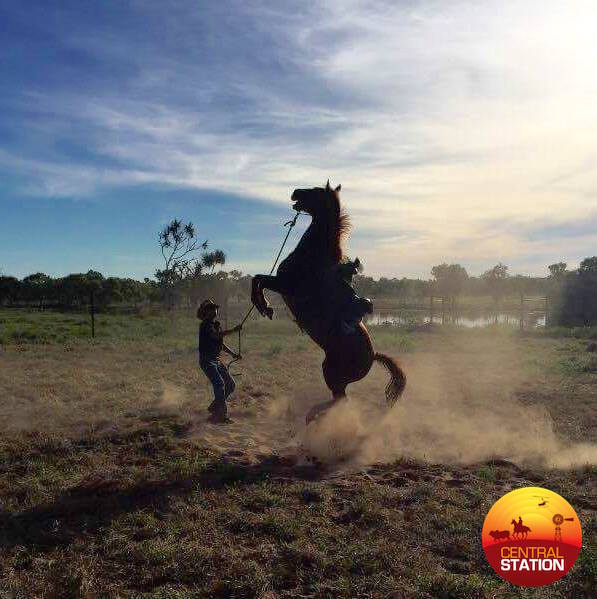 This is an older horse that was a little fresh!
This is an older horse that was a little fresh!
Then mustering begins. To get the horses to the paddock that’s being mustered we load them on an old Blitz, and she sure is a good old truck! This can take a lot of time and patience with the young horses that haven’t been on a truck before. The riders sit on top of the truck and have to watch their heads as sometimes we have to go under some pretty low branches!
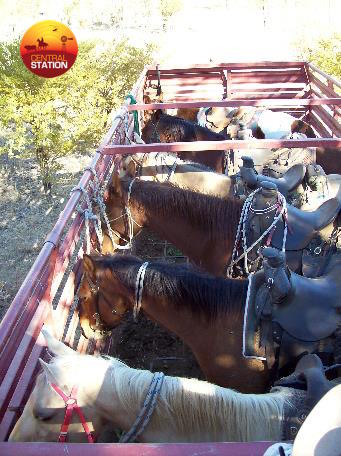 Ready for mustering.
Ready for mustering.
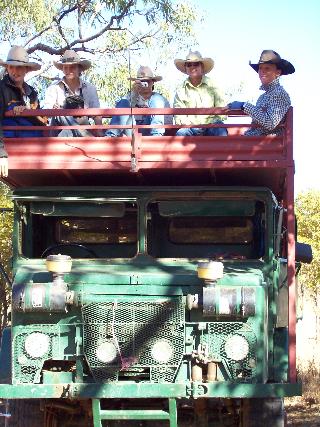 Staff ready to go out on the old blitz.
Staff ready to go out on the old blitz.
Once we start getting cattle the horses generally wait while the chopper and bikes bring cattle to them. It can be a little touch and go when the mob is only small and there are a few weaners to try and keep under control. Weaners generally have only been mustered once before when they were calves and still on their mothers. It takes a lot of riding around and turning their heads back into the mob without setting them off!
Once the mob is all together we start making our way back to the yards with them. There will be two or three horses in the lead to keep the mob steady at the start (they end up following the horses once they have relaxed), one on the tail end of the mob to keep them moving, and a few on either side (the wings) to keep the together. The bikes go wherever they needed. Crossing the river is the most heart racing as the cattle think that they can beat us and they start running and spreading out. The river is 1km wide in some places. We always get the chopper to help us cross the river to either help block the lead or bring back cattle that have gone out of sight. It is quite a rush to be in the lead of a mob of cattle that are trying to get away! You always have to keep in mind though that there is sink sand in the river and just to be careful enough! If your horse does go down in sink sand never get off as your horse may jump on you trying to get out, just sit calmly and guide your horse out.
It’s not just mustering when we use our horses, on days off or after we finish a day of working weaners at camp we take our horses down the river for a swim. It is fantastic for the younger ones to gain trust and it’s good on the older ones too just for a bit of fun!
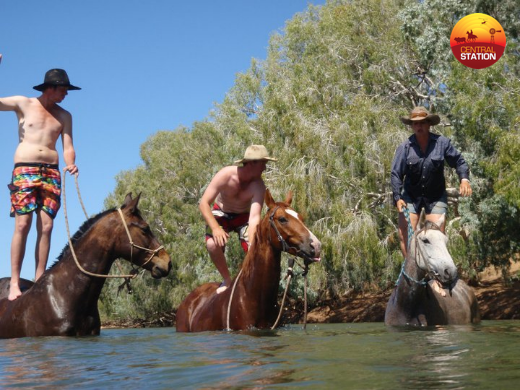 Having some horse fun in the river.
Having some horse fun in the river.
We are not at Abingdon anymore and are on the fattening block on the downs so unfortunately our use of horses is very limited now. There is too much black soil here which makes it hard on a horse. So these days our horse riding is a leisurely jog down the road or leading the kids around on their pony “Bullzeye”. But never will I forget the names of most of the 70 horses that run at Abingdon.
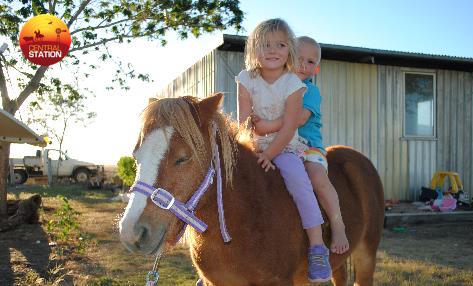 Claire and Riley on Bullzeye.
Claire and Riley on Bullzeye.
